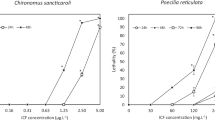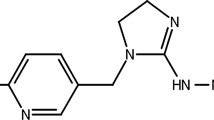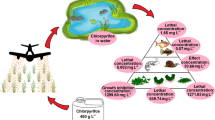Abstract
Diflubenzuron (DFB) is a larvicide widely used to control Aedes aegypti populations as an alternative to organophosphates (OPs), with a specific mechanism of action for insects by inhibiting their chitin synthesis. However, DFB is used extensively in urban and rural environments, having the aquatic environment as the major receptor. Thus, the present study aimed to investigate the toxicity of DFB-based formulation and compare it with the toxicity of the OP temephos (TMP)-based formulation, a larvicide still used to control A. aegypti, on freshwater fishes Oreochromis niloticus and Hyphessobrycon eques. Organisms were submitted to acute (48 h) and prolonged (7 days) exposures, in the presence and absence of organic sediment, seeking interactions between chemical and sediment. Histopathological analyses were performed on O. niloticus gills and liver. According to 48-h median lethal concentration (LC50), DFB- and TMP-based formulations were classified as harmful and toxic to fish, respectively, following the Globally Harmonized System of Classification (GHS). After prolonged exposure to sublethal concentrations, DFB-based formulation decreased H. eques body weight at concentrations 272-fold lower than its LC50. Ultrastructural responses of O. niloticus indicated edemas and aneurisms on gills, and hepatocyte hypertrophy and vascular congestion of the liver. TMP-based formulation also induced pyknotic nuclei, which may lead to irreversible necrosis. The addition of organic sediment did not alter the larvicide toxicity, suggesting that larvicides remained available to the organisms. Altogether, these results suggest that as an insect-specific pesticide, DFB still induces mortality and tissue damage in fishes; thus, both larvicides pose risks to fishes.



Similar content being viewed by others
References
Abe, F.R., Coleone, A.C., Machado, A.P., Machado-Neto, J.G. (2014). Ecotoxicity and environmental risk assessment of larvicides used in the control of Aedes aegypti to Daphnia magna (Crustacea, Cladocera). Journal of Toxicology and Environmental Health, Part A: Current Issues, 77(1–3), 37–45. https://doi.org/10.1080/15287394.2014.865581.
Ba-Omar, T. A., Al-Jardani, S., & Victor, R. (2011). Effects of pesticide temephos on the gills of Aphanius dispar (Pisces: Cyprinodontidae). Tissue & Cell, 43, 29–38. https://doi.org/10.1016/j.tice.2010.11.002.
Barillet, S., Larno, V., Floriani, M., Devaux, A., & Adam-Guillermin, C. (2010). Ultrastructural effects on gill, muscle, and gonadal tissues induced in zebrafish (Danio rerio) by a waterborne uranium exposure. Aquatic Toxicology, 100, 295–302. https://doi.org/10.1016/j.aquatox.2010.08.002.
Barros, A. L., Cavalheiro, G. F., Souza, A. V. M., Traesel, G. K., Anselmo-Franci, J. A., Kassuya, C. A. L., & Arena, A. C. (2014). Subacute toxicity assessment of diflubenzuron, an insect growth regulator, in adult male rats. Environmental Toxicology, 31(4), 407–414. https://doi.org/10.1002/tox.22054.
Bellinato DF, Viana-Medeiros PF, Araújo SC, Martins AJ, Lima JBP, Valle D (2016) Resistance status to the insecticides temephos, deltamethrin, and diflubenzuron in Brazilian Aedes aegypti populations. BioMed Res Int. ID 8603263. doi https://doi.org/10.1155/2016/8603263.
Brazil. Ministry of Health. Secretariat of Health Surveillance (2019). Monitoramento dos casos de dengue, febre de chikungunya e doença aguda pelo vírus Zika até a Semana Epidemiológica 52 de 2018. Epidemiological Bulletin, 50(04). Available in: http://portalarquivos2.saude.gov.br/images/pdf/2019/janeiro/28/2019-002.pdf. Accessed in: 4 Feb. 2019.
Carraschi, S. P., Cruz, C., Machado-Neto, J. G., Ignácio, N. F., Barbuio, R., & Machado, M. R. F. (2012). Histopathological biomarkers in pacu (Piaractus mesopotamicus) infected with aeromonas hydrophila and treated with antibiotics. Ecotoxicology and Environmental Safety, 83, 115–120. https://doi.org/10.1016/j.ecoenv.2012.06.016.
Cruz, C., Carraschi, S. P., Shiogiri, N. S., Silva, A. F., Pitelli, R. A., & Machado, M. R. F. (2016). Sensitivity, ecotoxicity and histopathological effects on neotropical fish exposed to glyphosate alone and associated to surfactant. Journal of Environmental Chemistry and Ecotoxicology, 8(3), 25–33. https://doi.org/10.5897/JECE2015.0362.
EPA, (1997). Reregistration Eligibility Decision (RED) – Diflubenzuron. United States Environmental Protection Agency, Washington, DC. Available in: https://www3.epa.gov/pesticides/chem_search/reg_actions/reregistration/red_PC-108201_1-Jun-97.pdf. Accessed in: 4 Feb. 2019.
Fanta, E., Rios, F. S., Romão, S., Vianna, A. C. C., & Freiberger, S. (2003). Histopathology of the fish Corydoras paleatus contaminated with sublethal levels of organophosphorus in water and food. Ecotoxicology and Environmental Safety, 54, 119–130. https://doi.org/10.1016/S0147-6513(02)00044-1.
Fischer, S. A., & Hall, L. W. (1992). Environmental concentrations and aquatic toxicity data on diflubenzuron (Dimilin). Critical Reviews in Toxicology, 22(1), 45–79.
Fukuto, T. R. (1990). Mechanism of action of organophosphorus and carbamate insecticides. Environmental Health Perspectives, 87, 245–254. https://doi.org/10.1289/ehp.9087245.
GHS (2017). Globally Harmonized System of Classification and Labelling of Chemicals (GHS). Globally Harmonized System, GHS, New York and Geneva, United Nations, ST/SG/AC.10/30/Rev.7.
Goindin, D., Delannay, C., Gelasse, A., Ramdini, C., Gaude, T., Faucon, F., David, J. P., Gustave, J., Vega-Rua, A., Fouque, F. (2017). Levels of insecticide resistance to deltamethrin, malathion, and temephos, and associated mechanisms in Aedes aegypti mosquitoes from the Guadeloupe and Saint Martin islands (French West Indies). Infect Dis Poverty 6(38). doi: https://doi.org/10.1186/s40249-017-0254-x.
Grisales, N., Poupardin, R., Gomez, S., Fonseca-Gonzalez, I., Ranson, H., & Lenhart, A. (2013). Temephos resistance in Aedes aegypti in Colombia compromises dengue vector control. PLoS Neglected Tropical Diseases, 7(9), e2438. https://doi.org/10.1371/journal.pntd.0002438.
Guimarães, A. T. B., Silva de Assis, H. C., & Boeger, W. (2007). The effect of trichlorfon on acetylcholinesterase activity and histopathology of cultivated fish Oreochromis niloticus. Ecotoxicology and Environmental Safety, 68, 57–62. https://doi.org/10.1016/j.ecoenv.2006.08.005.
Hamilton, M. A., Russo, R. C., & Thurston, R. V. (1977). Trimmed Spearman-Karber method for estimating median lethal concentrations in toxicity bioassays. Environmental Science & Technology, 11, 714–719. https://doi.org/10.1021/es60130a004.
Hinton, D. E., & Lauren, D. J. (1990). Integrative histopathological approaches to detecting effects of environmental stressors on fishes. In R. Adams & R. Lloyd (Eds.), Biological indicators of stress in fish. Bethesda: American Fisheries Society.
Hurst, T. P., Kay, B. H., Ryan, P. A., & Brown, M. D. (2007). Sublethal effects of mosquito larvicides on swimming performance of larvivorous fish Melanotaenia duboulayi (Atheriniformes: Melanotaeniidae). Journal of Economic Entomology, 100(1), 61–65. https://doi.org/10.1093/jee/100.1.61.
Kavitha, P., & Rao, J. V. (2009). Sub-lethal effects of profenofos on tissue-specific antioxidative responses in a Euryhyaline fish, Oreochromis mossambicus. Ecotoxicol Environ Saf., 72, 1727–1733. https://doi.org/10.1016/j.ecoenv.2009.05.010.
Lewis, K. A., Tzilivakis, J., Warner, D., & Green, A. (2016). An international database for pesticide risk assessments and management. Human and Ecological Risk Assessment: An International Journal, 22(4), 1050–1064. https://doi.org/10.1080/10807039.2015.1133242.
Lores, E. M., Moore, J. C., Moody, P., Clark, J., Forester, J., & Knight, J. (1985). Temephos residues in stagnant ponds after mosquito larvicide applications by helicopter. Bulletin of Environmental Contamination and Toxicology, 35, 308–313.
Lim, L., Bolstad, H. M. (2018). Organophosphate insecticides: Neurodevelopmental effects. In: Reference Module in Earth Systems and Environmental Sciences. https://doi.org/10.1016/B978-0-12-409548-9.10930-3
Medeiros, L. S., Souza, J. P., Winkaler, E. U., Silvia, P. C., Cruz, C., Souza-Júnior, S. C., & Machado-Neto, J. G. (2013). Acute toxicity and environmental risk of teflubenzuron to Daphnia magna, Poecilia reticulata and Lemna minor in the absence and presence of sediment. Journal of Environmental Science and Health. Part. B, 48(7), 600–606. https://doi.org/10.1080/03601234.2013.775000.
Mesnage, R., Defarge, N., Spiroux de Vendômois, J., & Séralini, G. E. (2015). Potential toxic effects of glyphosate and its commercial formulations below regulatory limits. Food and Chemical Toxicology, 84, 133–153. https://doi.org/10.1016/j.fct.2015.08.012.
Molina, C., Durand, G., & Barceló, D. (1995). Trace determination of herbicides in estuarine waters by liquid chromatography-high-flow pneumatically assisted electrospray mass spectrometry. Journal of Chromatography. A, 712, 113–122.
Mulla, M. S. (1995). The future of insect growth regulators in vector control. Journal of the American Mosquito Control Association, 11(2), 269–273.
Nascimento, A. A., Araújo, F. G., Gomes, I. D., Mendes, R. M. M., & Sales, A. (2012). Fish gills alterations as potential biomarkers of environmental quality in a eutrophized Tropical River in South-Eastern Brazil. Anatomia Histologia Embryologia, 41, 209–216. https://doi.org/10.1111/j.1439-0264.2011.01125.x.
OECD. (1992). Test No. 203: Fish, Acute Toxicity Test, OECD Guidelines for the Testing of Chemicals, Section 2. Paris: OECD Publishing. https://doi.org/10.1787/9789264069961-en.
Olsvik, P. A., Samuelsen, O. B., Erdal, A., Holmelid, B., & Lunestad, B. T. (2013). Toxicological assessment of the anti-salmon lice drug diflubenzuron on Atlantic cod Gadus morhua. Diseases of Aquatic Organisms, 105, 27–43. https://doi.org/10.3354/dao02613.
Patil, V. K., & David, M. (2010). Behavioral and morphological endpoints: as an early response to sublethal malathion intoxication in the freshwater fish, Labeo rohita. Drug and Chemical Toxicology, 33(2), 160–165. https://doi.org/10.3109/01480540903196816.
Pierce, R. H., Henry, M. S., Kelly, D., & Kozlowski, W. (2000). Hazard assessment of temephos applied to a southwest Florida, USA, salt marsh community. Environmental Toxicology and Chemistry, 19(2), 501–507.
Sánchez-Bayo, F. (2011). Insecticides mode of action in relation to their toxicity to non-target organisms. Journal of Environmental & Analytical Toxicology, S4, 002. https://doi.org/10.4172/2161-0525.S4-002.
Selvi, M., Sarikaya, R., Erkoç, F., & Koçak, O. (2005). Investigation of acute toxicity of chlorpyrifos-methyl on guppy Poecilia reticulata. Chemosphere, 60, 93–96. https://doi.org/10.1016/j.chemosphere.2004.11.093.
Singh, R. N. (2013). Effects of dimethoate (30% EC), an organophosphate pesticide on liver of common carp, Cyprinus carpio. Journal of Environmental Biology, 34, 657–661.
Singh, S., Tiwari, R. K., & Pandey, R. S. (2018). Evaluation of acute toxicity of triazophos and deltamethrin and their inhibitory effect on AChE activity in Channa punctatus. Toxicol Reports, 5, 85–89. https://doi.org/10.1016/j.toxrep.2017.12.006.
Souza, J. P., Medeiros, L. S., Winkaler, E. U., & Machado-Neto, J. G. (2011). Acute toxicity and environmental risk of diflubenzuron to Daphnia magna, Poecilia reticulata and Lemna minor in the absence and presence of sediment. Pesticidas: R Ecotoxicol Meio Ambiente, 21, 1–12.
Swann, R. L., Laskowski, D. A., Mccall, P. J., Kuy, K. V., & Dishburger, H. J. (1983). A rapid method for the estimation of the environmental parameters octanol/water partition coefficient, soil sorption constant, water to air ratio and water solubility. Residue Reviews, 85, 17–28.
Tilak, K. S., & Kumari, R. S. (2009). Acute toxicity of Nuvan®, an organophosphate to freshwater fish Ctenopharyngodon idella and its effect on oxygen consumption. Journal of Environmental Biology, 30(6), 1031–1033.
Uner, N., Sevgiler, Y., & Piner, P. (2010). Tissue-specific in vivo inhibition of cholinesterases by the organophosphate fenthion in Oreochromis niloticus. Environmental Toxicology, 25(4), 391–399. https://doi.org/10.1002/tox.20514.
USEPA. U.S. Environmental Protection Agency (2000). The use of data on cholinesterase inhibition for risk assessments of organophosphorous and carbamate pesticides. Washington, DC. Available in: https://www.epa.gov/sites/production/files/2015-07/documents/cholin.pdf. Accessed in: 18 Apr. 2018.
USEPA. U.S. Environmental Protection Agency (2017). Pesticides Industry Sales and Usage: 2008–2012 Market Estimates. Washington, DC. Available in: https://www.epa.gov/sites/production/files/2017-01/documents/pesticides-industry-sales-usage-2016_0.pdf. Accessed in: 18 Apr. 2018.
Viana-Medeiros, P. F., Bellinato, D. F., Martins, A. J., & Valle, D. (2017). Insecticide resistance, associated mechanisms and fitness aspects in two Brazilian Stegomyia aegypti (=Aedes aegypti) populations. Medical and Veterinary Entomology, 31, 340–350. https://doi.org/10.1111/mve.12241.
World Health Organization. (2018). Dengue and Severe Dengue. Factsheet on dengue. Available in: http://www.who.int/news-room/fact-sheets/detail/dengue-and-severe-dengue. Accessed in: 13 Sep. 2018.
Zaidi, N., & Soltani, N. (2011). Environmental risks of two chitin synthesis inhibitors on Gambusia affinis: chronic effects on growth and recovery of biological responses. Biological Control, 59, 106–113. https://doi.org/10.1016/j.biocontrol.2011.04.001.
Zhang, Z. Y., Yu, X. Y., Wang, D. L., Yan, H. J., & Liu, X. J. (2010). Acute toxicity to zebrafish of two organophosphates and four pyrethroids and their binary mixtures. Pest Management Science, 66, 84–89. https://doi.org/10.1002/ps.1834.
Acknowledgments
We thank the Ministry of health of Brazil for providing the formulations of the larvicides, and the Aquaculture Center of the São Paulo State University (CAUNESP) and its employees, especially Márcio Alves, for providing the fishes for this work.
Funding
This study was financially supported by the Brazilian National Council for Scientific and Technological Development (CNPq grant number: 152513/2010-8).
Author information
Authors and Affiliations
Contributions
All authors contributed equally.
Corresponding author
Ethics declarations
Conflict of Interest
The authors declare that they have no conflict of interest.
Additional information
Publisher’s Note
Springer Nature remains neutral with regard to jurisdictional claims in published maps and institutional affiliations.
Electronic supplementary material
ESM 1
(DOCX 293 kb)
Rights and permissions
About this article
Cite this article
Abe, F.R., Machado, A.A., Coleone, A.C. et al. Toxicity of Diflubenzuron and Temephos on Freshwater Fishes: Ecotoxicological Assays with Oreochromis niloticus and Hyphessobrycon eques. Water Air Soil Pollut 230, 77 (2019). https://doi.org/10.1007/s11270-019-4128-7
Received:
Accepted:
Published:
DOI: https://doi.org/10.1007/s11270-019-4128-7




